Did you know that using the law of conservation of energy can be much easier to deliver cargo to the moon, the exchange of masses?
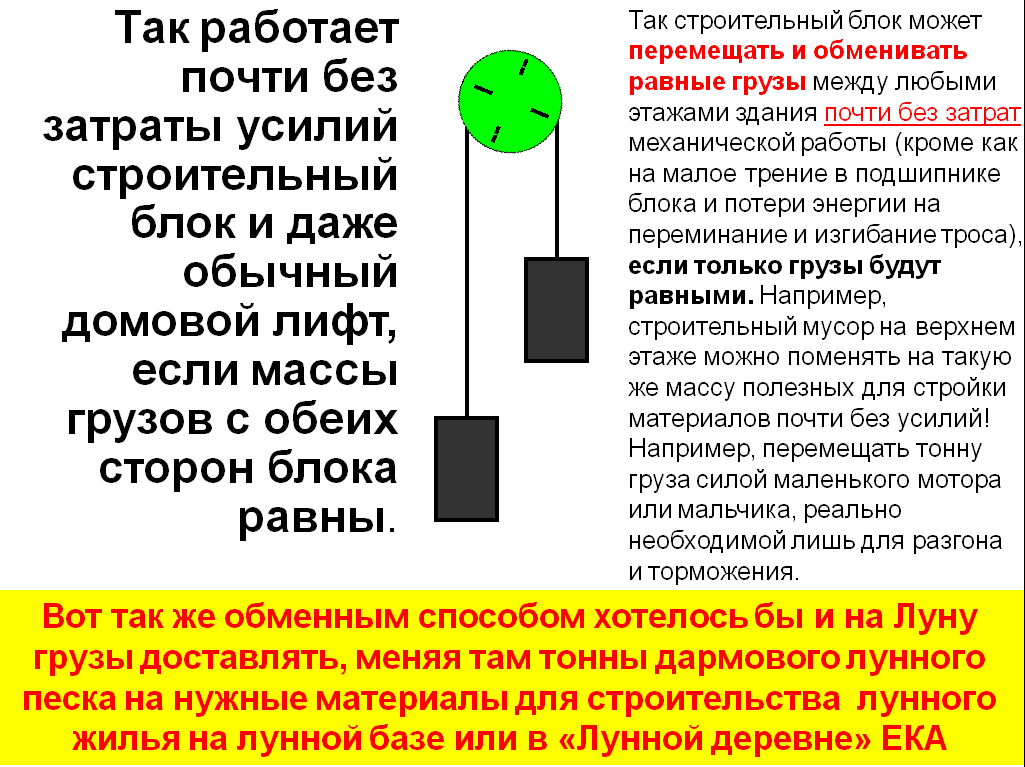
It is a bit like how it is done by the building block: one load is lowered, and the other, equal in mass, is lifted. Only for this you will not need a cable with a length of 380 thousand km!

Yes, and 36 thousand km to the GSO as a space elevator Artsutanova-Clark, too, since such unreal structures we do not need. Although it is clear that it was on two such elevators (the lunar and the terrestrial) that it would be possible, using the law of energy conservation, it is much easier to deliver cargo to the moon in exchange for the same mass of lunar soil to be lowered here using energy recovery. But to my great joy, there are no materials for the Earth space elevator, and it is not expected, and I can feel like Columbus of new technologies.
For the time being, we will go into orbit in the old manner of the Mask rockets, for example, Falcon Hevi, but not launched from Cape Canaveral, but from the equator. There, in the equatorial plane, the orbits of our satellites and sling will not precess due to the flattening of the Earth, therefore they will remain in one plane, which will allow our satellites to move from one orbit to another using exchange sashes.

The properties of inertia and elliptical orbits, discovered by Kepler, make it possible to carry out an almost no-cost journey of cargo in space vacuum from the LEO (low earth orbit) to the near-moon orbit and even to its surface. That is, if you learn to exchange orbits 2 satellites of equal mass with special sling. As you understand, such an exchange is not prohibited by any of the conservation laws, of which three are known in mechanics: ZSE, ZSI and ZSMI. Since velocities (or more precisely, their vectors) exchange objects of equal masses, all these laws are not violated, and the sling is an ideal tool for this, which carries out such an exchange almost without loss of mechanical energy, since its tension during exchange is not is changing!
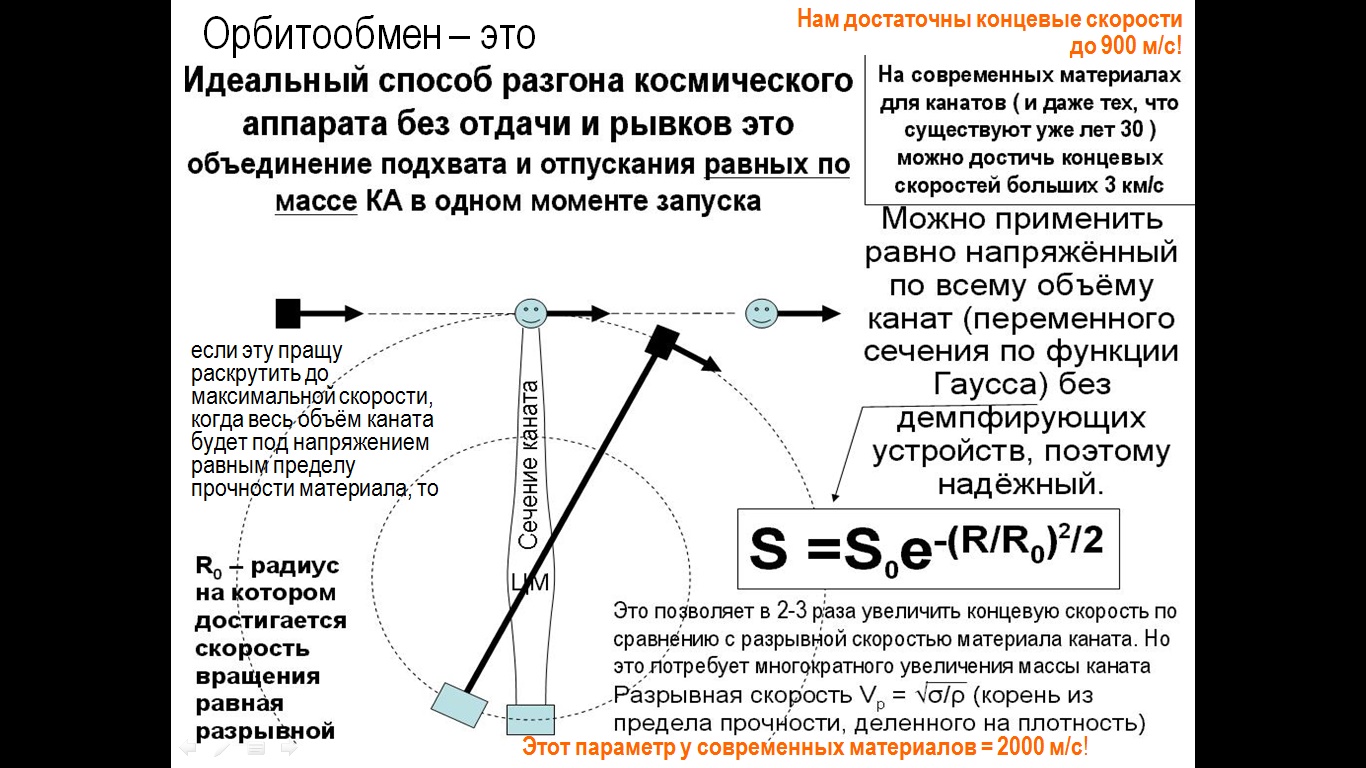
But sling is a little difficult for you to immediately understand everything, how it will work. Pay attention to the picture with billiard balls. Everyone who plays billiards knows that with a frontal impact on a standing ball, the balls simply exchange velocity vectors: the striker stops and the player gains the speed of the first one. If this happens in space orbit - this will also be ORBITRING!
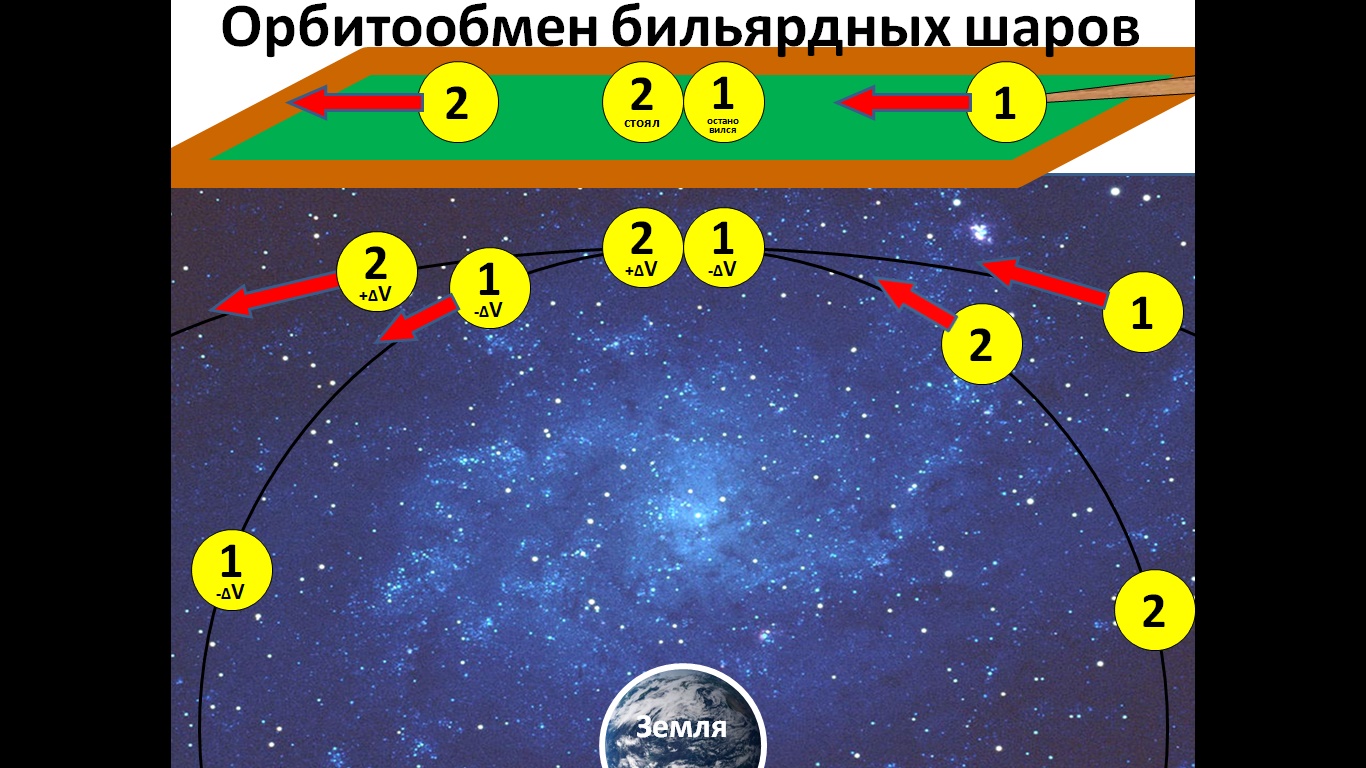
Here is a sequence of such exchanges, even between billiard balls, in principle, you can get to the surface of the moon! Starting from the NOU and ending with the collision of a ball resting on the top of the moon mountain with another ball, rushing in circumlunar orbit at a speed of 1680 m / s!
Of course, an absolutely elastic impact at such a speed is not possible (an explosion will simply occur and the energy will turn into heat), but this problem is solved with the help of two sling, rotating at half speed of 840 m / s, which is quite real.
From orbits with multiple periods of revolution, one can construct an exchange conveyor to the Moon itself. This multiplicity of periods is simply necessary for periodic convergences of exchanging satellites of equal masses (one of them is the payload for the lunar base, and the other is ballast from the lunar soil) and orbital slings in orbit-touch zones, where exchanges will take place.
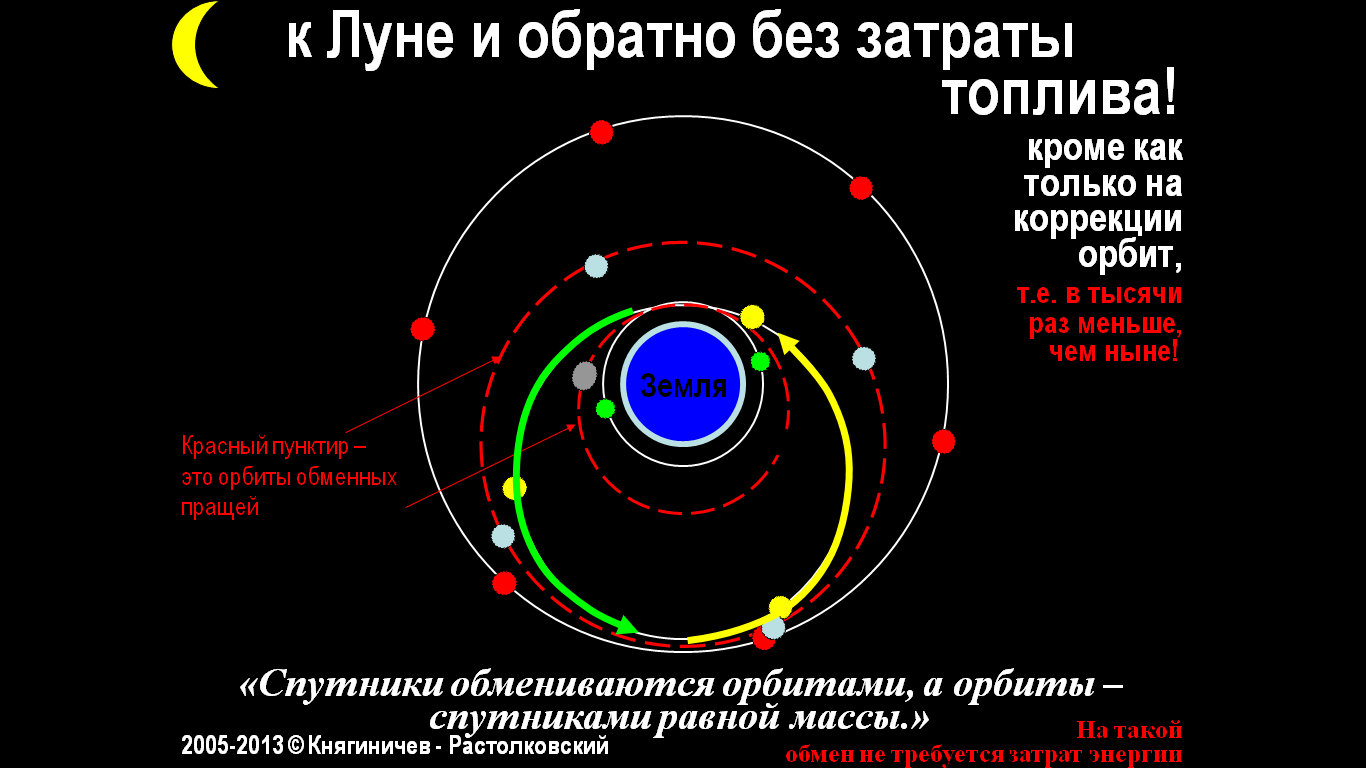
Moreover, during a single passage through the zone of exchanges (where the orbit is concerned), it is possible to make not one, but dozens or even hundreds of exchanges! A very efficient conveyor can turn out when the total mass of cargo exchanged in one pass of a zone will exceed the weight of a sling with its two weights at the ends a hundred times. And such an operation is possible every lunar month (once in 27.32 days).
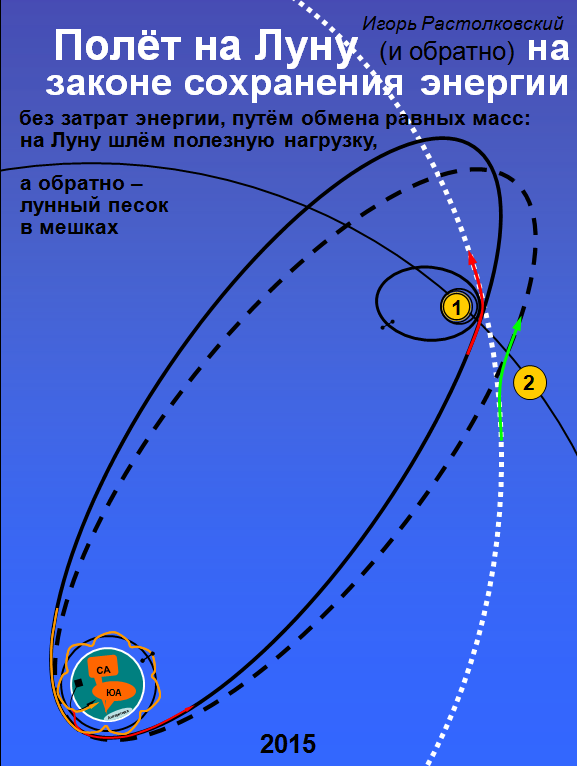
That is, we can deliver dozens of tons of cargo to the Moon every month, without spending 90% of the rocket fuel on the mass of the payload to be delivered to the NOU, as is done using conventional rocket technology. All that is displayed on the LEO (and not 10% as it is now) will be delivered to the moon! On the orbit correction only 1-2% of the mass of the mass that will be delivered to the Moon can be spent, i.e., 900 times less: compare 1% of the required fuel during ORBITRING and 9/10 of the load delivered to the NOU during rocket delivery !
This will reduce the regular costs of delivering goods to the moon 10 times, and the construction of this “pipeline to the moon” may not be expensive at all!
Most of all at the present time (tens of thousands of dollars per 1 kg) there is the removal of tens or even hundreds of exchange cargo (for high monthly performance of the conveyor) to high target orbits. And 6-7 slings should be brought there, to different high and near-moon orbits. Plus, for the delivery of cargo to the moon, you will need receiving carousels at the poles of the moon and in other important places — ports on its surface. This delivery of conveyor elements will cost only as a 3-4 month volume of cargo delivered to the moon by him. That is not so expensive in relation to the economic effect.
At the same time, there are a lot of life hacks that make the cost of this construction delivery cheaper. Starting with the promised Mask 1000 $ per 1 kg per NOU. Further, the use of part of the conveyor (to the orbit with a radius of 3.43 Earth radius) as part of the exchange transport system to the GSO. There are constantly accumulating high-mass satellites of 3-5 tons that have served their time! This "garbage" can be replaced with sling on new satellites. In this case, the fuel is not required, but now it requires 75%. That is, the delivery to the GSO will be cheaper by 4 times!
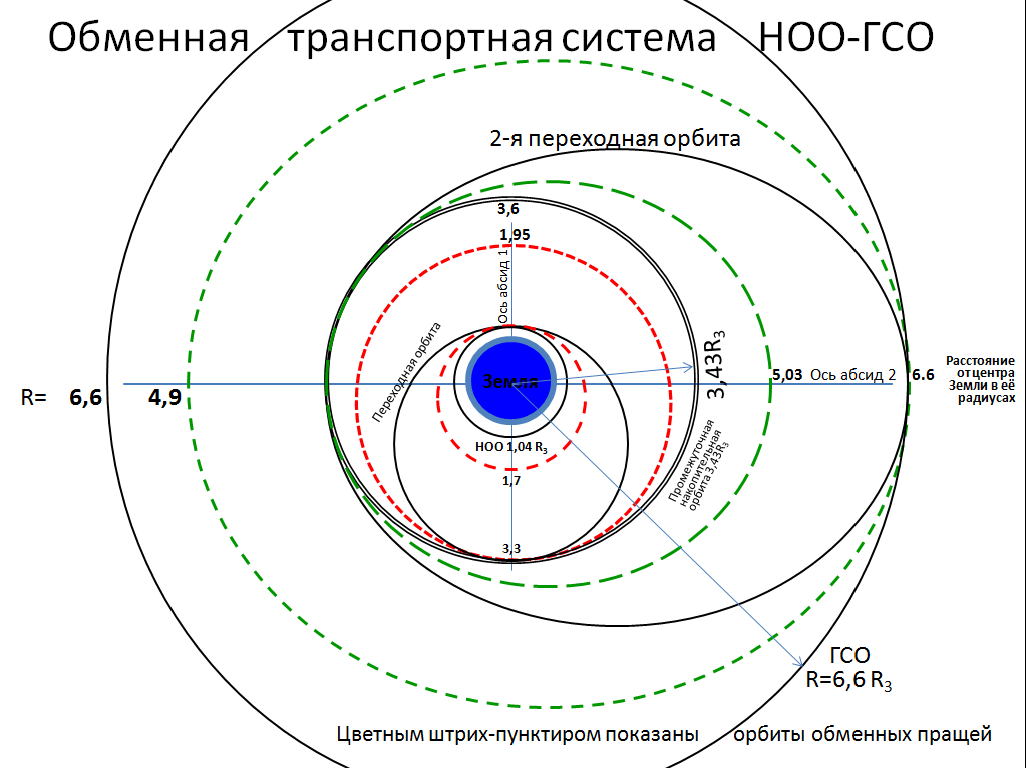
Waste from this activity (trimming of old satellites descended from the GSO) will accumulate at the NOU above the equator. Do not cause outrage of the inhabitants of equatorial countries, throwing tons of artificial meteorites on their heads all this garbage! It can be used partly as radiation protection for a tourist commercial orbital station, partly as a reactive working body for it. The grains of any metal can be thrown back by a railgun at a speed of 15 km / s relative to the station, flying in orbit at a speed of 7.7 km / s. Krupinkam remains relative to the Earth 7.3 km / s backward speed. And they will be beautiful falling stars fall into the atmosphere, pleasing the eye of the locals and attracting tourists for them. These stars can be strewed and by request! In the right place at the right time. And even advertising inscriptions in the sky write out different colors
By the way, the exchange cargo can be launched from the moon with slings every 100 times easier in terms of energy consumption than from the earth, since their efficiency is high, and the required throw speed from the moon is only 2.5 km / s. From the Earth, together with the gravitational losses of rockets, the characteristic speed of 10 km / s is required, 4 times more! Energy savings are 16 times, and the efficiency of rockets is about 10-20 percent. But the main thing is that throwing away is cheap! Cheaper than an electromagnetic catapult.
This makes it easy for us to increase by 80% to the project “pipeline capacity to the moon” of hundreds of tons per month, because 90% of exchange cargo can be run from the moon. Well, “the first 10% of the entire mass of the conveyor” can be brought out with conventional rockets — then, “only” dozens of tons of equipment will be delivered to the moon for a start. Scourges and energy, housing and LSS for the first inhabitants of the Moon - adjusters of all the equipment of the lunar base.
But this is not the limit of price reduction: the exchange cargo can be launched from the Earth’s quasi-satellite, a recently discovered asteroid. Then the cost of creating a "pipeline to the moon" will be reduced almost only to R & D and R & D to create enough small sling for nanosatellites and test them in target orbits.
Then the dimensions (and weights) of the slings and exchange loads can be increased to a ton, which is enough to deliver almost any cargo that cannot be divided into parts. In the future, it will even be capsules with a person. But this (delivery of people to the moon in exchange capsules with sling length of 17-34 km with permissible maximum overloads of less than 4.2-8.4) is a matter of the distant future - first loads of structural elements will go, which can be subjected to overloads up to 85, and from which you can collect everything you need on the moon. At the same time, the total length of the sling between two weights at opposite ends will be only 1,700 meters with a rotation speed of 850 m / s.
Since the orbit exchange flight to the Moon requires, on average, more time than the rocket, the ORBITRING of lunar orbital slings will first begin to be transported between the lunar roundabout ports and not between the Earth and the Moon. The overload in orbit will not be high there, for example, 2.2 with a rotation radius of 33.6 km. But on the carousel (in the port), the pioneers of the Moon will have to suffer a few minutes before going into orbit or after descending from it, for example, 8.4! When accelerating to 840 m / s or braking from this speed. This is with a rope length and a radius of rotation of 8.4 km. But for the carousel does not require a very high tower: 8.4 km / 6 / 8.4 same = 1 km / 6 = 170 meters. It is approximately estimated cost of materials as on Earth tower height of 30 meters. By the way, there are no winds on the moon ... so it will not be expensive:
So people and cargo on the moon over long distances will move in a low orbit at a speed of 1680 m / s, simultaneously rotating in a vertical plane at the ends of the orbital sling relative to their center of mass at a speed of 840 m / s.
So at the lowest point the speed relative to the lunar surface will be equal to half the orbital - the same 840 m / s.
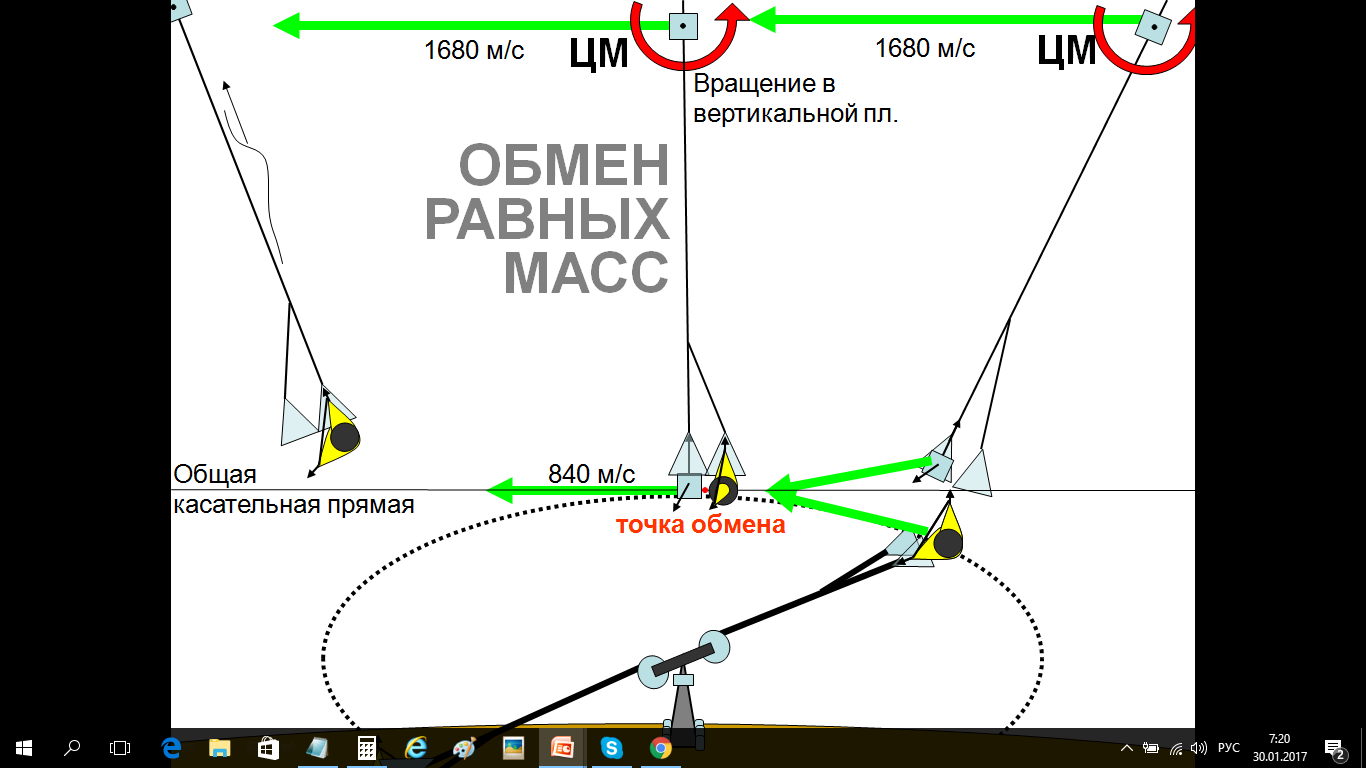
This allows cargoes and capsules with a person to get to this point in an exchangeable way with a roundabout standing on the surface of the Moon, also being spun horizontally up to the speed of 840 m / s At the same time, the load of the same mass will come off the sling on the carousel, which will be stopped to remove the load (or capsule).
All cargo will go into orbit and be removed from it without serious rocket fuel costs (only for minor corrections) and travel mainly in polar orbits. From the polar orbit, the entire surface of the moon is available in ½ of its revolution, i.e. in 2 weeks. If you bring out 14 sling on 14 polar orbits, which will paint the moon with their trajectories like a watermelon on 28 black stripes, then the entire surface of the moon, any point will be accessible from these sling 1 time per day. Transfer points will be roundabouts at the poles - these are the two most important lunar ports: "Who owns them - owns the whole Moon!" (C) My words, music ... Belmondo)
Can you imagine what kind of tourist Mecca the Moon will turn into? The roundabouts will be set apart from the poles near all 6 Apollo landing sites. Give me 6 more monumental craters, on the edges of which for the beginning it is worthwhile to put the towers of the roundabouts. For starters, there will be 14 - for optimal cost of materials: the number of roundabouts is equal to the number of orbital sling.
I would also like to write here a roadmap of the transfer of cosmonautics to ORBIT-CHANGE, but I will only say that we must begin with periodic precise convergence of nanosatellites in orbit, preferably equatorial. But this will require a launch not from Russia, but from the Kourou cosmodrome. First, we need to launch 3 navigation cubes for close orbits with a height of 575 km and a period of 96 minutes - 15 turns per day.
From the distance to these 3 satellites, it is possible to obtain accurate data on the location of other nanosatellites in order to measure the parameters and correct their orbits in the volume of a thin ring-torus around this circular orbit. It is enough that the size of this precise navigation zone is about 10 km, but the accuracy can be easily and cheaply reached about 1-10 cm! It may even be a university student project.
At the beginning, satellites approaching with equal periods of 96 minutes at each turn will be tested. And then convergence of satellites with multiple periods of 1/15 and 1/14 days, this convergence at a relative speed of 170 m / s will rarely occur once every two weeks, but it will be possible to accurately target and orbit exchange at the speed of rotation of the slings 170 m /with. Then you can proceed to the launch of such a sling.
